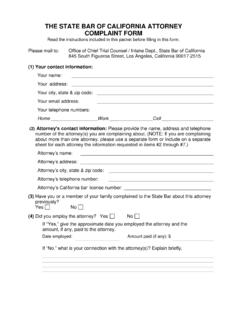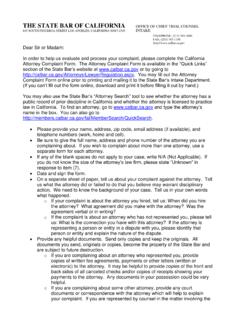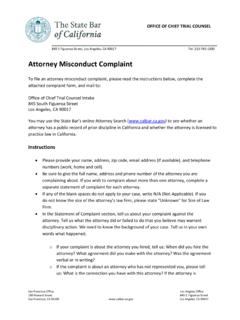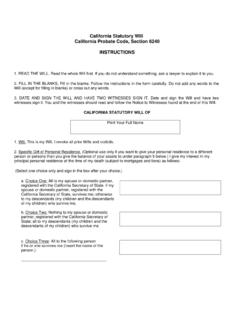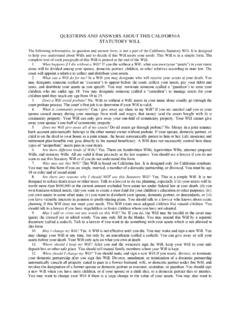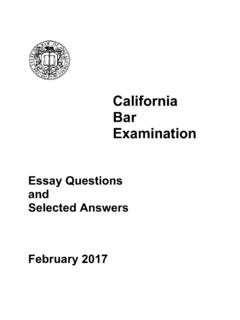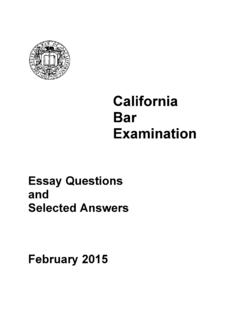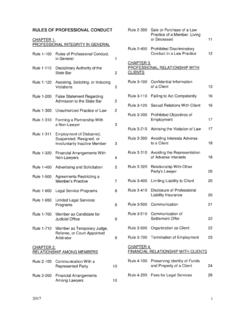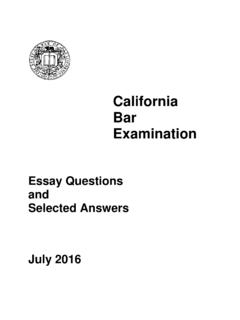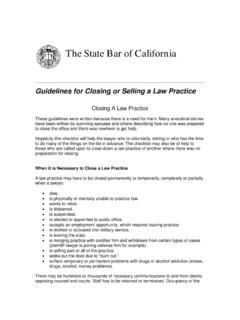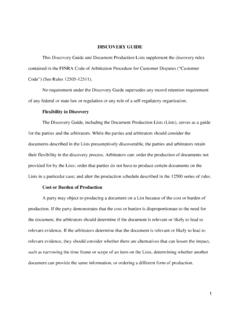Transcription of Rule 1.6 Confidential Information of a Client (Rule ...
1 1 Rule Confidential Information of a Client (Rule Approved by the Supreme Court, Effective November 1, 2018) (a) A lawyer shall not reveal Information protected from disclosure by Business and Professions Code section 6068, subdivision (e)(1) unless the Client gives informed consent,* or the disclosure is permitted by paragraph (b) of this rule. (b) A lawyer may, but is not required to, reveal Information protected by Business and Professions Code section 6068, subdivision (e)(1) to the extent that the lawyer reasonably believes* the disclosure is necessary to prevent a criminal act that the lawyer reasonably believes* is likely to result in death of, or substantial* bodily harm to, an individual, as provided in paragraph (c). (c) Before revealing Information protected by Business and Professions Code section 6068, subdivision (e)(1) to prevent a criminal act as provided in paragraph (b), a lawyer shall, if reasonable* under the circumstances: (1) make a good faith effort to persuade the Client : (i) not to commit or to continue the criminal act; or (ii) to pursue a course of conduct that will prevent the threatened death or substantial* bodily harm; or do both (i) and (ii); and (2) inform the Client , at an appropriate time, of the lawyer s ability or decision to reveal Information protected by Business and Professions Code section 6068, subdivision (e)(1) as provided in paragraph (b).
2 (d) In revealing Information protected by Business and Professions Code section 6068, subdivision (e)(1) as provided in paragraph (b), the lawyer s disclosure must be no more than is necessary to prevent the criminal act, given the Information known* to the lawyer at the time of the disclosure. (e) A lawyer who does not reveal Information permitted by paragraph (b) does not violate this rule. Comment Duty of confidentiality [1] Paragraph (a) relates to a lawyer s obligations under Business and Professions Code section 6068, subdivision (e)(1), which provides it is a duty of a lawyer: To maintain inviolate the confidence, and at every peril to himself or herself to preserve the secrets, of his or her Client . A lawyer s duty to preserve the confidentiality of Client Information involves public policies of paramount importance.
3 (In Re Jordan (1974) 12 575, 580 [116 371].) Preserving the confidentiality of Client Information contributes to the trust that is the hallmark of the lawyer- Client relationship. The Client is thereby encouraged to seek legal assistance and to communicate fully and frankly with the lawyer even as to embarrassing or detrimental subjects. The lawyer needs this Information to represent the Client effectively and, if necessary, to advise the Client to 2 refrain from wrongful conduct. Almost without exception, clients come to lawyers in order to determine their rights and what is, in the complex of laws and regulations, deemed to be legal and correct. Based upon experience, lawyers know* that almost all clients follow the advice given, and the law is upheld. Paragraph (a) thus recognizes a fundamental principle in the lawyer- Client relationship, that, in the absence of the Client s informed consent,* a lawyer must not reveal Information protected by Business and Professions Code section 6068, subdivision (e)(1).
4 (See, , Commercial Standard Title Co. v. Superior Court (1979) 92 934, 945 [155 ].) Lawyer- Client confidentiality encompasses the lawyer- Client privilege, the work-product doctrine and ethical standards of confidentiality [2] The principle of lawyer- Client confidentiality applies to Information a lawyer acquires by virtue of the representation, whatever its source, and encompasses matters communicated in confidence by the Client , and therefore protected by the lawyer- Client privilege, matters protected by the work product doctrine, and matters protected under ethical standards of confidentiality, all as established in law, rule and policy. (See In the Matter of Johnson (Rev. Dept. 2000) 4 Cal. State Bar Ct. Rptr. 179; Goldstein v. Lees (1975) 46 614, 621 [120 253].) The lawyer- Client privilege and work-product doctrine apply in judicial and other proceedings in which a lawyer may be called as a witness or be otherwise compelled to produce evidence concerning a Client .
5 A lawyer s ethical duty of confidentiality is not so limited in its scope of protection for the lawyer- Client relationship of trust and prevents a lawyer from revealing the Client s Information even when not subjected to such compulsion. Thus, a lawyer may not reveal such Information except with the informed consent* of the Client or as authorized or required by the State Bar Act, these rules , or other law. Narrow exception to duty of confidentiality under this rule [3] Notwithstanding the important public policies promoted by lawyers adhering to the core duty of confidentiality, the overriding value of life permits disclosures otherwise prohibited by Business and Professions Code section 6068, subdivision (e)(1). Paragraph (b) is based on Business and Professions Code section 6068, subdivision (e)(2), which narrowly permits a lawyer to disclose Information protected by Business and Professions Code section 6068, subdivision (e)(1) even without Client consent.
6 Evidence Code section , which relates to the evidentiary lawyer- Client privilege, sets forth a similar express exception. Although a lawyer is not permitted to reveal Information protected by section 6068, subdivision (e)(1) concerning a Client s past, completed criminal acts, the policy favoring the preservation of human life that underlies this exception to the duty of confidentiality and the evidentiary privilege permits disclosure to prevent a future or ongoing criminal act. Lawyer not subject to discipline for revealing Information protected by Business and Professions Code section 6068, subdivision (e)(1) as permitted under this rule [4] Paragraph (b) reflects a balancing between the interests of preserving Client confidentiality and of preventing a criminal act that a lawyer reasonably believes* is 3 likely to result in death or substantial* bodily harm to an individual.
7 A lawyer who reveals Information protected by Business and Professions Code section 6068, subdivision (e)(1) as permitted under this rule is not subject to discipline. No duty to reveal Information protected by Business and Professions Code section 6068, subdivision (e)(1) [5] Neither Business and Professions Code section 6068, subdivision (e)(2) nor paragraph (b) imposes an affirmative obligation on a lawyer to reveal Information protected by Business and Professions Code section 6068, subdivision (e)(1) in order to prevent harm. A lawyer may decide not to reveal such Information . Whether a lawyer chooses to reveal Information protected by section 6068, subdivision (e)(1) as permitted under this rule is a matter for the individual lawyer to decide, based on all the facts and circumstances, such as those discussed in Comment [6] of this rule.
8 Whether to reveal Information protected by Business and Professions Code section 6068, subdivision (e) as permitted under paragraph (b) [6] Disclosure permitted under paragraph (b) is ordinarily a last resort, when no other available action is reasonably* likely to prevent the criminal act. Prior to revealing Information protected by Business and Professions Code section 6068, subdivision (e)(1) as permitted by paragraph (b), the lawyer must, if reasonable* under the circumstances, make a good faith effort to persuade the Client to take steps to avoid the criminal act or threatened harm. Among the factors to be considered in determining whether to disclose Information protected by section 6068, subdivision (e)(1) are the following: (1) the amount of time that the lawyer has to make a decision about disclosure; (2) whether the Client or a third-party has made similar threats before and whether they have ever acted or attempted to act upon them; (3) whether the lawyer believes* the lawyer s efforts to persuade the Client or a third person* not to engage in the criminal conduct have or have not been successful.
9 (4) the extent of adverse effect to the Client s rights under the Fifth, Sixth and Fourteenth Amendments of the United States Constitution and analogous rights and privacy rights under Article I of the Constitution of the State of California that may result from disclosure contemplated by the lawyer; (5) the extent of other adverse effects to the Client that may result from disclosure contemplated by the lawyer; and (6) the nature and extent of Information that must be disclosed to prevent the criminal act or threatened harm. 4 A lawyer may also consider whether the prospective harm to the victim or victims is imminent in deciding whether to disclose the Information protected by section 6068, subdivision (e)(1). However, the imminence of the harm is not a prerequisite to disclosure and a lawyer may disclose the Information protected by section 6068, subdivision (e)(1) without waiting until immediately before the harm is likely to occur.
10 Whether to counsel Client or third person* not to commit a criminal act reasonably* likely to result in death or substantial* bodily harm [7] Paragraph (c)(1) provides that before a lawyer may reveal Information protected by Business and Professions Code section 6068, subdivision (e)(1), the lawyer must, if reasonable* under the circumstances, make a good faith effort to persuade the Client not to commit or to continue the criminal act, or to persuade the Client to otherwise pursue a course of conduct that will prevent the threatened death or substantial* bodily harm, including persuading the Client to take action to prevent a third person* from committing or continuing a criminal act. If necessary, the Client may be persuaded to do both. The interests protected by such counseling are the Client s interests in limiting disclosure of Information protected by section 6068, subdivision (e) and in taking responsible action to deal with situations attributable to the Client .
